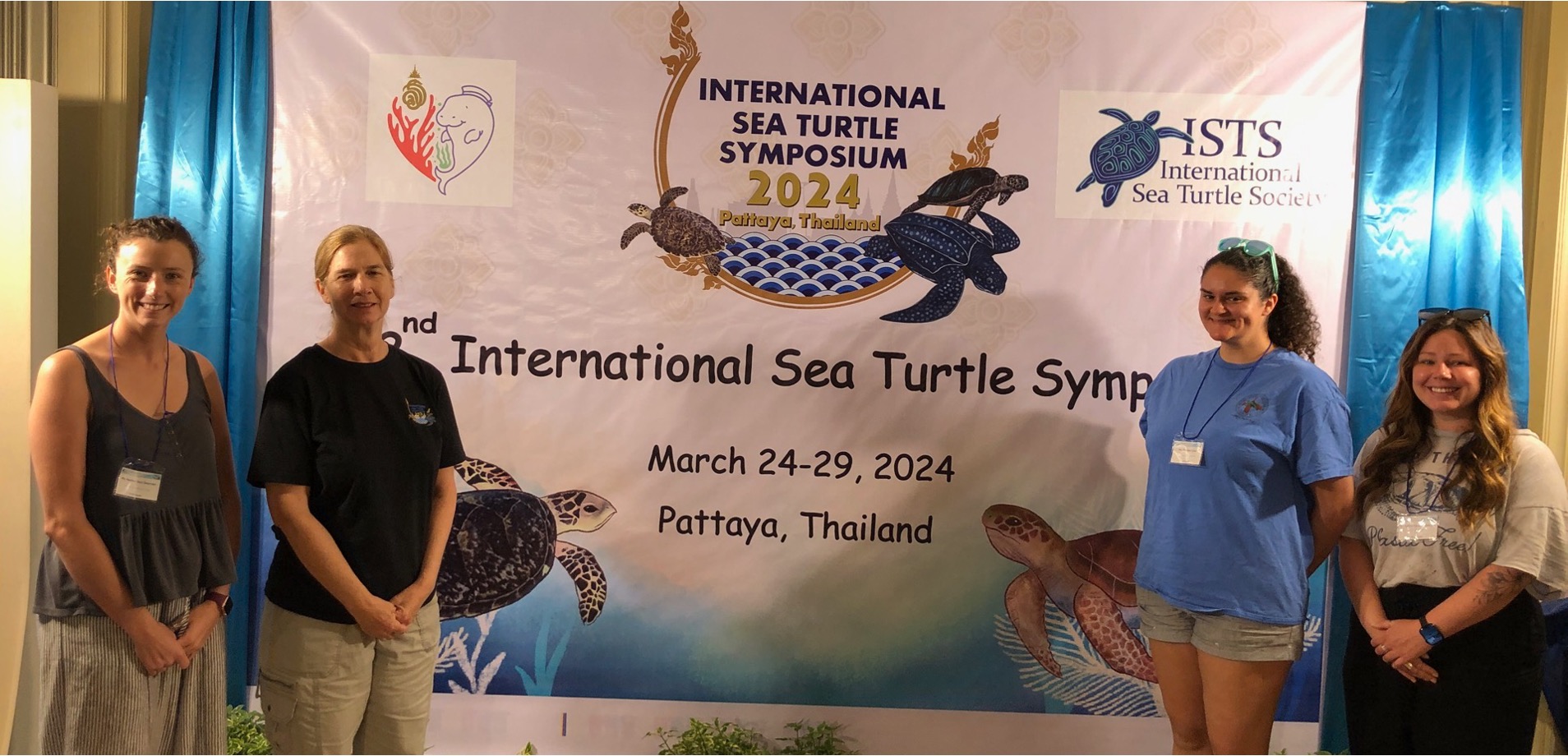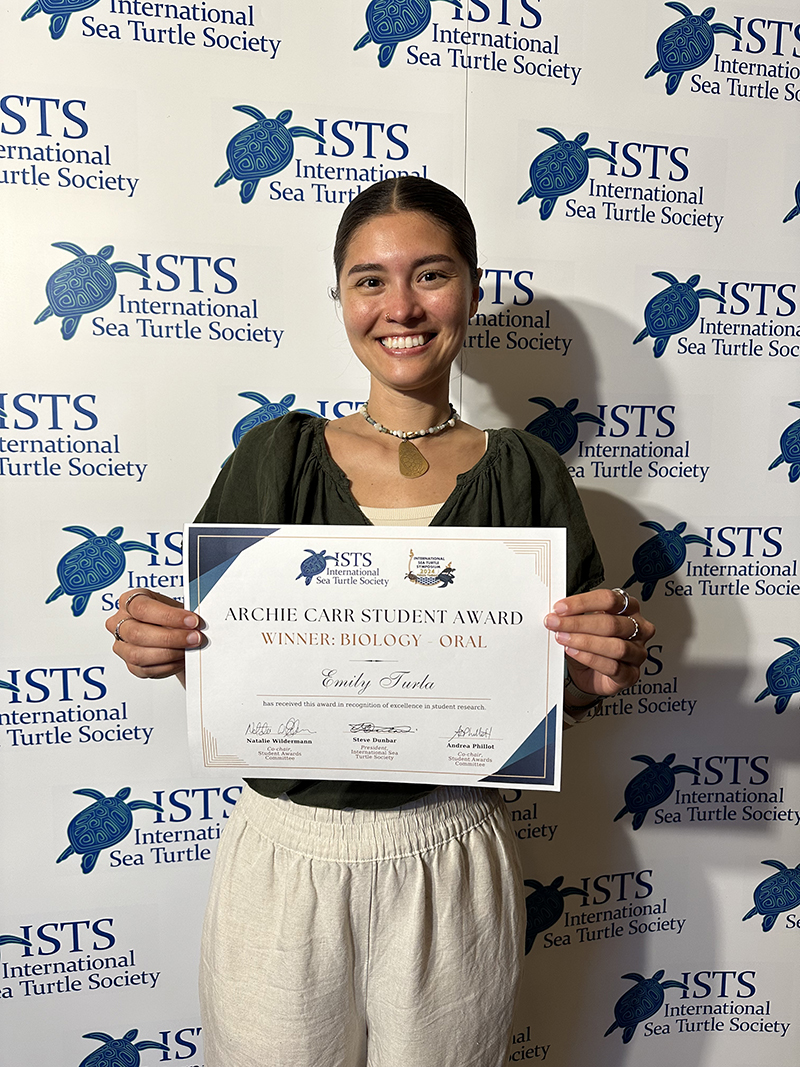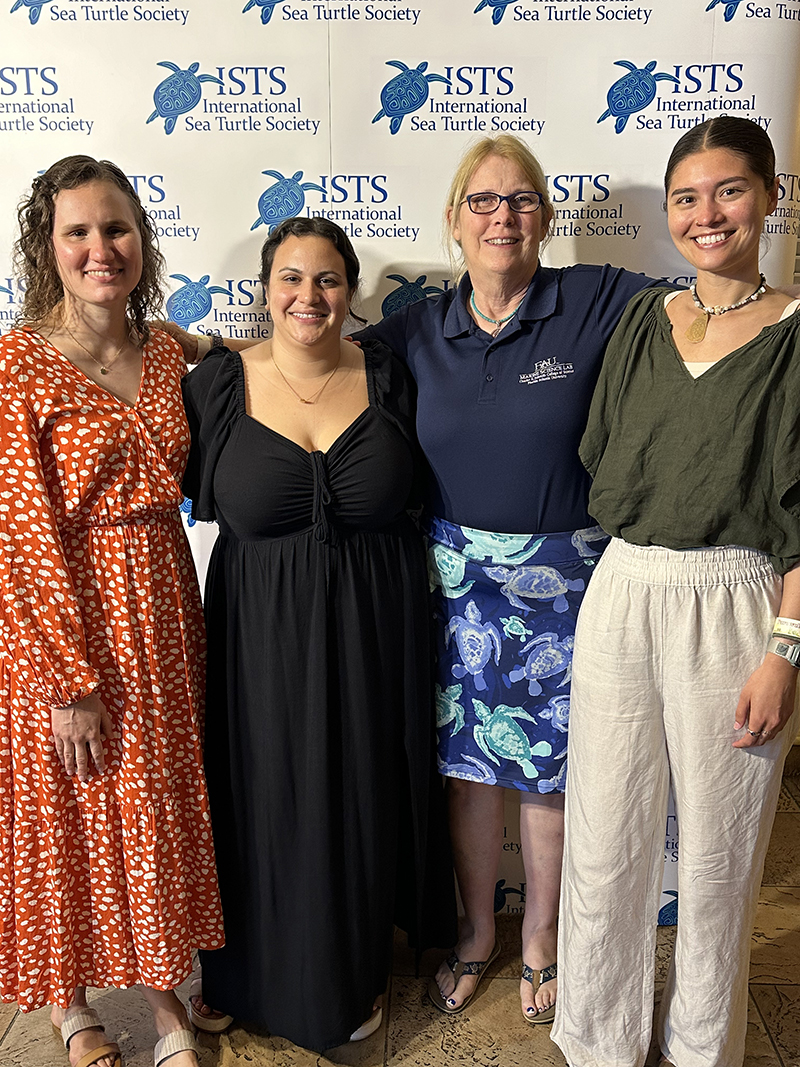
FAU Turtlers Take Thailand: 2024 International Sea Turtle Symposium
Author: Sam Trail
Date: May 26, 2024
In March, students and faculty from the FAU Marine Lab traveled all the way to Pattaya, Thailand to present their groundbreaking research at the 2024 International Sea Turtle Symposium (ISTS). Members of the Marine Lab, along with their collaborators, presented ten different research projects. Below, we present brief summaries of each study.
- D. Candidate and FAU Marine Lab Coordinator, Emily Turla, is investigating the importance of two sources of leatherback egg failure: (i) infertility, or (ii) a failure of fertilized eggs to produce embryos capable of completing development. Using a variety of techniques, Emily was able to distinguish between these two sources egg failure, enabling her to determine that normally the fertility rate is high. However, problems in development are persistent in leatherback nests, at least in those undergoing incubation in southeastern Florida. Emily received the Archie Carr Student Award for best biology oral presentation for her research – way to go, Emily!

- Gabby Carvajal, a Ph.D. Candidate and Glenn W. and Cornelia T. Bailey Marine SEA Scholar, continues to unravel the challenges of identifying sex-specific biomarkers in the blood of sea turtle hatchlings. Gabby presented on the complexities of using a potential “favorite”, Anti-Müllerian Hormone (AMH), as a possible sex-specific protein, and why it may not be a reliable candidate for determining whether a hatchling is male or female. Thus, she continues the search for a reliable indicator, one that will be essential for determining hatchling sex ratios at nesting beaches around the world.
- Samantha Kuschke, DVM and recent Ph.D. graduate, described the impact of rising incubation temperatures on key blood values and skin microbiota of leatherback hatchlings. Her results suggest that hatchlings from hotter nests are physiologically stressed, and that stress once again affects their health after one month of growth and development. Because our beaches continue to warm, this factor could have a major impact on the survival of young leatherbacks. Sam successfully defended her Ph.D. dissertation while in Thailand and is now a Postdoctoral Researcher at FAU – way to go, Sam!
- Raschelli Linz, a Ph.D. Candidate, presented two posters at ISTS! Schelli investigated the impact of harmful algal blooms (HABs) on loggerhead, Kemp’s ridley, and green sea turtles. She found that concentrations of toxins associated with HABs did not differ significantly among these three species of sea turtles. This finding was a surprise, because these species of turtles differ in both their distribution in coastal waters, as well as their dietary preferences! Schelli also investigated the potential impactt of HABs on leatherback sea turtles, considered primarily an open-ocean species. Despite their open-ocean lifestyle, Leatherbacks are known to forage in near-shore areas, So, they may be exposed to the toxins from HABs, making them more susceptible to diseases like Fibropapillomatosis (FP). However, Schelli found that despite foraging in these near-shore areas, nesting leatherback females did not exhibit FP, suggesting leatherbacks may be less susceptible to FP than other sea turtle species.
- Heather Seaman, a Ph.D. Candidate, investigated the presence of plastic marine debris in stranded sea turtles across Florida. Heather analyzed the plastic type, color, and volume of ingested plastic found in the GI tract of stranded sea turtles across different species and life stages (based on size). Most of the plastic marine debris she collected was hard plastic and white, clear, or blue in color. Green turtles were more likely to have plastic in their GI tract than other turtles. Surprisingly, the size of the turtle did not have a significant impact on the amount of ingested plastic. Heather’s research is ongoing, and she will continue to investigate not only the incidents of plastic ingestion, but the physiological impacts of that ingestion on the general health and survival of sea turtles.
- Rachel Southards, a previous undergraduate student in the FAU Marine Lab and now a MS student in FAU’s Geosciences department, presented her research on plastic ingestion by green sea turtles. Rachel investigated whether the amount of ingested plastic differed between stranded turtles with and without Fibropapillomatosis (FP). This disease appears to be most prevalent in coastal waters with high levels of pollution. It was previously thought that FP infection was also associated with plastic ingestion. However, Rachel found that there was no statistically significant association between the amount of plastic ingested and FP infection among the green turtles she sampled.
- Jeanette Wyneken, Director of the FAU Marine Lab, and Dr. Michael Salmon, Emeritus Professor of Biological Sciences, provided an answer to the age-old question: ‘Why the long face?’ They compared skull shape and foraging behavior between hawksbill and green sea turtles. Both consume algae growing on the surface of shallow reefs in Hawaii. They found that hawksbills, which have long, narrow heads and V-shaped jaws, seek algae lodged in reef crevices. Green turtles, on the other hand, had blunt, rounded heads with U-shaped jaws, scraped algae away from flat rocky surfaces. These difference in skull shape and feeding site location probably enable the two species to feed on the same prey while simultaneously avoiding competition for a potentially limited supply of food.
- Sarah Milton, Chair of FAU’s Department of Biological Sciences, presented research in collaboration with two graduate students from her lab, Alexis Moyle and Christina Cortez, who could not attend the conference in Thailand. Lexi’s study indicated that loggerhead hatchlings from hotter nests were smaller and were also weaker swimmers than the turtles from cooler nests. This difference could impact hatchling survival as nesting beaches continue to warm. Christina studied the antibiotic resistant bacteria present in the hindgut of wild-caught loggerhead and green sea turtles. Interestingly, the greatest resistance was found among the bacteria treated with antibiotics used in human medicine, and not those used to treat sea turtles during their rehabilitation.
Way to go, turtlers! We are so proud of your work and hope you enjoyed your adventure across the globe to Thailand!



